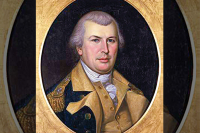Early mapping of the Nantahala
The economic destiny of a given region is ultimately determined by its geology, flora and climate. That’s certainly been the instance here in the Smokies region, where logging and mining have been supplanted as the major industries by recreation and ecotourism. A casebook example of this transition exists in the southwestern tip of North Carolina. A key figure in this story was Arthur Keith, an early twentieth century geologist who has been largely (if not totally) neglected by regional historians.
The Murphy Marble Belt is an elongated, lens-shaped mass of marble and related sedimentary materials up to three miles wide that extends in a crescent from northwestern Georgia into Cherokee and Swain counties. This lens also contains talc, limestone, soapstone, and calcareous soils. The first two materials are still mined at the Nantahala Talc and Limestone Co. in the Nantahala Gorge. But it was marble that was once the linchpin of the area’s mining interests.
Some extraction of marble took place in Swain and Cherokee counties during the 19th century. But it wasn’t until the arrival of the railroad from Asheville in the 1890s that moving the excavated blocks became economically feasible on a large scale.
Then, in the latter half of the 20th century, the marble industry declined and ultimately ceased to exist in southwestern North Carolina. It was apparently more feasible in economic terms to extract and transport marble mined in the Georgia end of the belt. At about the time the marble industry was phasing out in the early 1970s, the whitewater industry arrived on the scene. And it, too, was based on geology.
In 1904, Arthur Keith of the U.S. Geological Survey observed the abnormal, almost right-angled bend to the east that the Nantahala River makes as it enters the lower portion of the Nantahala Gorge (where the power plant and raft put-in areas are presently situated). Keith theorized that the river originally ran northward from the Georgia line directly through a water gap (just east of present Topton) into the Tulula Creek watershed in present Graham County, and on into the Little Tennessee below where Fontana Dam was built.
The situation represents a textbook instance of “stream piracy,” whereby a small creek eating back westward through the soft, limestone strata of the Murphy Marble Belt in the lower gorge captured the original Nantahala, causing it to change course and flow back to the east, thereby creating the dramatic Nantahala Gorge as we know it today. In other words, a geologic event that took place millions of years ago culminated in a regional economy that went from dependency on hard marble blocks to soft rubber rafts in less than a single generation.
Related Items
Near the big bend in the Nantahala River there is a state historical marker honoring botanist William Bartram’s excursion into the region in the mid-1770s. A marker commemorating Arthur Keith’s work there in the early twentieth century would not be inappropriate. The National Academy of Sciences published Chester R. Longwell’s memoir titled Arthur Keith (1864-1944) in 1956:
“The name of Arthur Keith is inseparably connected with Appalachian geology. During most of his mature life, over a period of nearly 50 years, his chief efforts were devoted to field study, mapping, and written description of selected areas distributed from the Carolinas to Maine. Sixteen folios of the United States Geological Survey, most of them under his name alone, a few prepared jointly with other workers, are in themselves a monument to his skill and industry ... He entered Harvard in 1881 and received his bachelor’s degree in 1885 ... At Harvard he rowed in the varsity crew, was a letter man in football, and became heavyweight wrestling champion. These athletic activities hardened and trained his naturally rugged physique, and helped prepare him for the strenuous field work in which he was engaged well beyond his seventieth year. Like many others in his generation at Harvard, Keith sat under Nathaniel Southgate Shaler and was fascinated by that master’s eloquence in presenting the fundamentals of geology ... In June, 1887, he became assistant in a field party of the United States Geological Survey, and spent the summer mapping in the mountains of eastern Tennessee. That experience determined the pattern of his later life. He went to Washington at the end of the field season, and became a regular member of the Federal Survey, which was still in the first decade of its vigorous early growth. The Geological Society of America was founded a year after Keith went to Washington, and he was elected to membership in 1889 ... For several decades Keith’s geologic folios in the Southern Appalachians were accepted as models, and three contiguous sheets — the Mount Mitchell, Roan Mountain, and Bristol quadrangles — were widely used as the most satisfactory geologic cross section of the Appalachian belt. His maps published between 1891 and 1907 represent detailed study and description of nearly 15,000 square miles, largely in areas with intricate bedrock structure. For nearly 20 years Keith spent his summers contentedly in strenuous field work, his winters in writing; and his high productivity continued unbroken. But at last he consented to take part in administration, and in 1906 he became chief of the Section of Areal Geology for the entire country. This assignment soon became too demanding for one man, and in 1913 a division was made into Eastern and Western Areas, with Keith in charge of the former ... He served as President of the Geological Society of Washington; as Councilor, Vice-President, and President (1927) of the Geological Society of America; as Chairman (1928-31) of the Division of Geology and Geography, National Research Council; as Council Member and Treasurer (1932-40) of the National Academy of Sciences.”
George Ellison wrote the biographical introductions for the reissues of two Appalachian classics: Horace Kephart’s Our Southern Highlanders and James Mooney’s History, Myths, and Sacred Formulas of the Cherokees. In June 2005, a selection of his Back Then columns was published by The History Press in Charleston as Mountain Passages: Natural and Cultural History of Western North Carolina and the Great Smoky Mountains. Readers can contact him at P.O. Box 1262, Bryson City, N.C., 28713, or at This email address is being protected from spambots. You need JavaScript enabled to view it..









